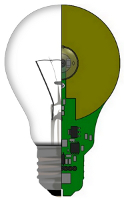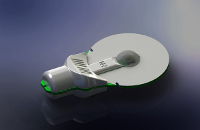Using a single circuit board to host COB LEDs and the driver electronics, NiteN hopes to significantly lower the cost of SSL lamps, but the startup could be late to the party.
NiteN has announced an LED retrofit lamp called the 2D-Lite LED Disk that the company says can hit the $10 price point for consumers in 2014 for an 800-lm, 60W-equivalent lamp. The unique design may not resonate immediately as a lightbulb replacement, but it appears as if it should produce uniform omnidirectional light and can be manufactured at low cost. That said, NiteN is a socially-funded startup that may or may not have the backing to launch the product and the socket-saturation clock is ticking on any new manufacturer trying to enter the retrofit lamp space.

We've refrained from covering socially-funded startups for the most part because frankly few have succeeded in the business-to-business technology space and there have been dozens targeting SSL — none of which have found success to date. The unique design of the NiteN product, however, makes it worthy of discussion.
A-lamp footprint
At first glance it looks little like a lightbulb, but the footprint is the same as the vertical centerline cross-section of a traditional incandescent lamp. The single printed-circuit board (PCB) that hosts the LEDs and driver electronics is shaped in that form. The design eliminates interconnects between the LEDs and driver electronics, and the metal-plated PCB acts as both a heat sink and reflector.
The design uses two chip-on-board (COB) LEDs that are mounted back to back on either side of the PCB. A COB LED alone wouldn't provide an omnidirectional beam pattern. NiteN founder Andy Turudic said, "A redistribution lens provides sweet hemispherical perfection from the LED lambertian pattern." Most often you see a collimating total internal reflection(TIR) lens used with smaller LEDs, but that is to narrow the beam pattern and wouldn't work with a larger COB. But in this case the dispersion lens is used to broaden the pattern and the reflective surface of the PCB adds to the beam spread.

The low-cost manufacturing angle is important. The 2D-Lite design would be assembled automatically on a surface-mount line. There are no wires requiring connections or hand soldering/assembly. Even the screw base of the lamp is implemented in part within the confines of the PCB. The plastic portion of the base that is evident in nearby photos does not have the Edison socket threads and is smooth. But look at the edges and you will see the Edison threads on each side of the PCB (the green vertical equator along the base). Moreover, the electrical connections between the PCB to the threads and to the contacts in the base of the socket are accomplished by contacts embedded on the PCB.
Timing and funding challenges
Despite the positives, NiteN faces an uphill challenge to bring the 2D-Lite design to market. The company needs funding to begin volume manufacturing including the expensive mold for the injection-molding required to build the plastic base. The company is trying to raise money on the Indiegogo social-funding site, and is part of the Philips Innovation Fellows program on that site.
The other challenges include the nontraditional look of the lamp and the relatively short time left for companies to capitalize in the retrofit lamps space. Founder Turudic said low cost will trump unconventional looks and that the design should hit the $6 price point in 2015 and drop to $3 in 2017. But even Philips Lighting seems to have learned that consumers want traditional-looking lamps. Of course, it wouldn't be terribly difficult to put a globe on the NiteN design, although that would impact the cost and possibly the thermal design.
The bigger question is probably the clock. Without question NiteN has misjudged how quickly the retrofit lamp space is moving. Even if things go perfectly for the startup, Cree, Philips, and probably others will beat them to market with $10 60W-equivalent lamps. The important factor is that the large companies have volume production and distribution arrangements in place to move hundreds of thousands of units instantly. And by the time 2017 rolls around, the market for retrofit lamps will be severely diminished as consumers will have installed many long-life lamps already.
The NiteN intellection property (IP), however, could be applied to luminaires as well. Turudic pointed out that the 2D-Lite LED Disk could serve perfectly in the typical surface-mount ceiling fixture that uses two incandescent lamps or compact fluorescent lamps (CFLs) in which half of the light is radiated upward and essentially wasted. NiteN could just power one side of its disk and halve power consumption to double efficacy in such a case.
The most likely path to success for the company, however, is probably sale or license of the IP to companies working on integral luminaires, or even a move into the luminaire space if the startup can find funding. The concepts are impressive, but we've seen many impressive concepts in the SSL space that were far better funded and yet have staggered to exit the startup phase.
About the Author Maury Wright is Editor of LEDs Magazine and Illumination in Focus.





